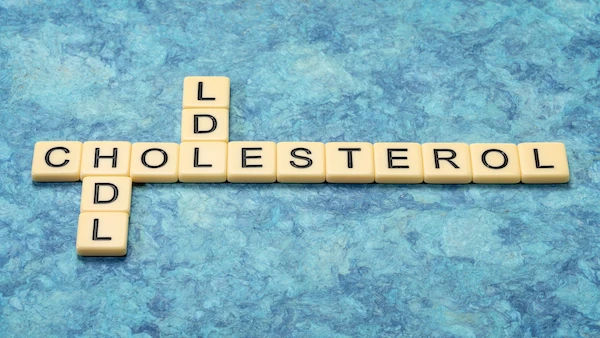The Importance of Triglycerides: Understanding Their Role in Health
Discover the role of triglycerides in your health, how they affect your body, and the importance of maintaining healthy levels to reduce the risk of heart disease and other health issues.

Written by
Last updated on 3rd Jul, 2025
Introduction
Triglycerides are a type of fat found in your blood, playing a vital role in energy storage and maintaining normal bodily functions. While often linked to heart disease and high cholesterol, triglycerides are not inherently bad. In fact, they are essential for many bodily processes. Understanding their importance, how they function, and their impact on health can help you make informed decisions to maintain overall well-being. This article delves into what triglycerides are, their role in the body, the significance of their levels, and tips for maintaining a healthy balance to reduce health risks.
What Are Triglycerides?
Triglycerides are a type of fat (lipid) found in your blood. After you eat, your body takes any extra calories it doesn’t need right away and converts them into triglycerides, which are stored in fat cells. Later, when your body needs energy—such as between meals—hormones release these triglycerides to fuel your cells. However, if you consistently eat more calories than your body can burn, especially from foods high in carbohydrates, your triglyceride levels can rise. This condition, known as hypertriglyceridemia, can increase your risk of developing heart disease and other health issues.
The Role of Triglycerides in the Body
Triglycerides play several crucial roles in the body, contributing to energy storage, protection, and overall health. Understanding their importance helps explain why maintaining healthy triglyceride levels is essential for cardiovascular health and overall well-being.
Energy Storage and Supply: Triglycerides are the body’s primary way of storing excess energy. When you consume more calories than your body needs, the extra calories—especially from fats and carbohydrates—are converted into triglycerides and stored in fat cells (adipocytes). Later, when your body needs energy, such as between meals or during physical activity, these triglycerides are broken down and released to fuel your cells.
Insulation and Protection: Triglycerides also play a role in insulating and protecting your internal organs. The fat cells that store triglycerides create a cushioning layer around vital organs, such as the heart, kidneys, and liver. This fatty layer acts as a shield, protecting these organs from physical damage and trauma.
Structural Support for Cell Membranes: While triglycerides don’t directly form cell membranes, they are part of a larger group of lipids that contribute to their structure. These lipids, including triglycerides, help keep cell membranes flexible and functional. This flexibility is crucial for maintaining healthy cells and allowing them to carry out their essential functions.
Absorption of Fat-Soluble Vitamins: Triglycerides help your body absorb fat-soluble vitamins—A, D, E, and K—from food. These vitamins are critical for processes like vision, bone health, immune function, and blood clotting. Triglycerides facilitate the transport of these vitamins through the digestive system and into the bloodstream, ensuring they are available for your body to use.
Hormone Production: Triglycerides play a role in the production of certain hormones. For example, they are precursors to steroid hormones like estrogen, testosterone, and cortisol. These hormones regulate important bodily functions such as metabolism, immune responses, and how the body reacts to stress.
Regulation of Blood Sugar: Triglycerides also help manage blood sugar levels. When blood glucose is low, triglycerides are broken down into fatty acids and glycerol. The glycerol can then be converted into glucose through a process called gluconeogenesis, providing an additional source of energy for the body.
The Health Risks of High Triglycerides
High triglyceride levels are a major risk factor for several health conditions, especially cardiovascular diseases:
Heart Disease
High triglycerides are often found in combination with other risk factors, such as high LDL (bad) cholesterol and low HDL (good) cholesterol. This combination can lead to atherosclerosis, the buildup of fatty deposits in the arteries, which narrows and hardens them, increasing the risk of heart attacks, strokes, and other cardiovascular problems.
Metabolic Syndrome
Triglycerides are a key component of metabolic syndrome, a cluster of conditions that include high blood pressure, elevated blood sugar, and abnormal cholesterol levels. People with metabolic syndrome are at a higher risk of developing type 2 diabetes and heart disease.
Pancreatitis
Extremely high levels of triglycerides—typically over 500 mg/dL—can lead to pancreatitis, an inflammation of the pancreas. Pancreatitis can cause severe abdominal pain, nausea, and vomiting, and if left untreated, it can be life-threatening.
Fatty Liver Disease
High triglycerides are strongly associated with non-alcoholic fatty liver disease (NAFLD). NAFLD occurs when excess fat builds up in the liver without alcohol consumption, which can lead to liver inflammation and, in severe cases, liver damage or cirrhosis.
Stroke and Other Vascular Issues
Just like heart disease, high triglyceride levels contribute to an increased risk of stroke and other vascular issues. Elevated triglycerides cause the thickening of the arteries, which can block blood flow to the brain, leading to strokes and other circulatory problems.
The Dangers of Low Triglycerides
While high triglycerides are well-known for their associated risks, having too low triglyceride levels can also have its drawbacks. Low triglycerides are less common but may indicate poor nutritional intake, malabsorption issues, or underlying health conditions such as hyperthyroidism. Extremely low triglycerides can affect the body's ability to store and use energy, leading to fatigue, weight loss, and compromised immune function.
How Triglycerides Are Measured?
Triglyceride levels are typically measured through a blood test called a lipid panel or lipid profile. This test measures the amount of cholesterol and triglycerides in your blood, giving you a comprehensive picture of your lipid health. A standard lipid panel will measure:
Total cholesterol
LDL cholesterol (bad cholesterol)
HDL cholesterol (good cholesterol)
Triglycerides
Triglyceride levels are expressed in milligrams per deciliter (mg/dL). The American Heart Association provides these general guidelines for triglyceride levels:
Normal: Less than 150 mg/dL
Borderline high: 150-199 mg/dL
High: 200-499 mg/dL
Very high: 500 mg/dL or higher
Maintaining Healthy Triglyceride Levels
Maintaining healthy triglyceride levels is crucial for overall health, particularly when it comes to reducing the risk of heart disease, stroke, and other cardiovascular issues. Fortunately, there are several effective strategies that can help keep your triglycerides within a healthy range. Here are some key steps you can take to maintain healthy triglyceride levels:
1. Eat a Balanced Diet
A healthy diet plays a central role in managing triglyceride levels. Focus on the following:
Limit sugar and refined carbs: Foods high in added sugars and refined carbohydrates—such as sugary drinks, baked goods, and white bread—can cause an increase in triglyceride levels. Reducing your intake of these can help lower triglycerides.
Choose healthy fats: Opt for unsaturated fats found in foods like olive oil, avocados, and nuts. These fats can help lower triglyceride levels, whereas saturated fats found in red meat and full-fat dairy products can raise them.
Increase fiber intake: Fiber-rich foods, such as whole grains, vegetables, fruits, and legumes, can help lower triglycerides by improving digestion and reducing the absorption of fat.
Eat more omega-3 fatty acids: Omega-3s, found in fatty fish like salmon, mackerel, and sardines, have been shown to significantly reduce triglyceride levels. If you don’t eat fish, omega-3 supplements can be a good alternative.
2. Exercise Regularly
Physical activity is one of the most effective ways to lower triglyceride levels. Aim for at least 30 minutes of moderate-intensity exercise most days of the week. Activities like brisk walking, cycling, swimming, or even dancing can help improve fat metabolism and lower triglycerides. Regular exercise also helps raise HDL (good) cholesterol, which further supports heart health.
3. Maintain a Healthy Weight
Excess weight, particularly abdominal fat, is strongly linked to high triglyceride levels. Losing even a modest amount of weight—about 5-10% of your body weight—can lead to a significant reduction in triglycerides. This can be achieved through a combination of a healthy diet and regular exercise.
4. Limit Alcohol Intake
Excessive alcohol consumption is known to raise triglyceride levels. Even moderate alcohol intake can lead to higher triglycerides in some people. If you have high triglycerides, it’s a good idea to reduce or eliminate alcohol to help bring your levels down.
5. Quit Smoking
Smoking not only lowers HDL (good) cholesterol but also contributes to higher triglyceride levels. Quitting smoking can help improve both your triglyceride levels and overall cardiovascular health.
6. Manage Underlying Health Conditions
Certain health conditions, such as diabetes, hypothyroidism, and kidney disease, can contribute to high triglyceride levels. Managing these conditions with the help of your healthcare provider is an important part of controlling your triglycerides. If you have diabetes, for example, keeping your blood sugar under control can help lower triglycerides.
7. Consider Medications (if necessary)
In some cases, lifestyle changes alone may not be enough to manage high triglyceride levels. Your healthcare provider may recommend medications, such as fibrates, omega-3 fatty acid supplements, or statins, to help lower your triglycerides. These medications are typically prescribed when triglyceride levels are very high or when other risk factors for heart disease are present.
8. Monitor Your Triglyceride Levels
Regular blood tests can help monitor your triglyceride levels and ensure they stay within a healthy range. If your levels are elevated, your healthcare provider can recommend the most appropriate interventions to bring them down.
Conclusion
Triglycerides are essential for energy storage and normal body function, but when their levels rise too high, they can increase the risk of serious health problems, such as heart disease, stroke, and metabolic syndrome. Regularly monitoring your triglyceride levels and making healthy lifestyle choices—like eating a balanced diet, exercising regularly, and maintaining a healthy weight—can help keep your triglycerides in a healthy range. By taking proactive steps to manage your triglyceride levels, you can protect your heart and overall health.
If you're concerned about your triglyceride levels or have been diagnosed with high triglycerides, it’s important to work closely with your healthcare provider to develop a personalised treatment plan.
Consult Top Cardiologist
Consult Top Cardiologist

Dr. Dayanashre N
General Physician
3 Years • MBBS
Bengaluru
PRESTIGE SHANTHINIKETAN - SOCIETY CLINIC, Bengaluru

Dr. Bhethala Sharan Prakash
General Physician/ Internal Medicine Specialist
5 Years • MBBS MD
Bengaluru
PRESTIGE SHANTHINIKETAN - SOCIETY CLINIC, Bengaluru

Dr. Anand Ravi
General Physician
2 Years • MBBS
Bengaluru
PRESTIGE SHANTHINIKETAN - SOCIETY CLINIC, Bengaluru

Dr. Tripti Deb
Cardiologist
40 Years • MBBS, MD, DM, FACC, FESC
Hyderabad
Apollo Hospitals Jubilee Hills, Hyderabad

Dr. Siddharth Bajaj
Cardiologist
10 Years • MBBS, M.D. D.M. (Cardiology)
Hyderabad
Apollo Hospitals Jubilee Hills, Hyderabad



